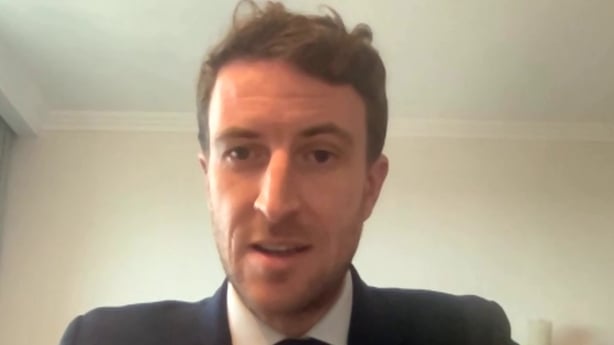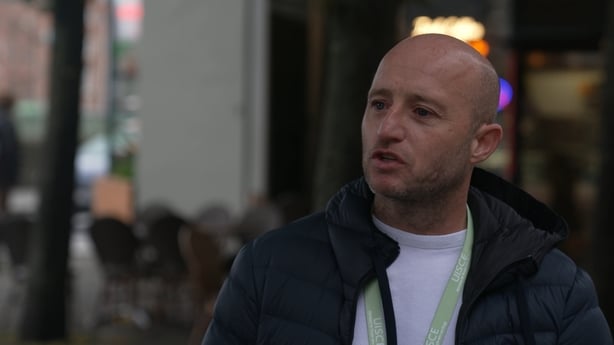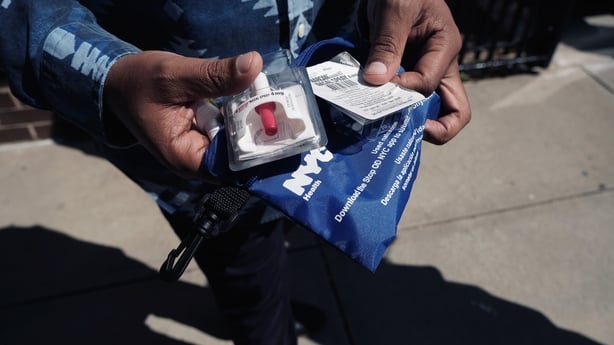In the space of just a few weeks Taoiseach Leo Varadkar, the Minister for Justice Helen McEntee and the head of the Garda National Drugs and Organised Crime Bureau Seamus Boland have all warned about the risk of fentanyl, a lethal, illicit drug potentially entering the Irish market.
The drug, which is up to 100 times more potent than morphine and many times that of heroin, has led to an explosion in overdose deaths in North America.
The HSE has said illicit fentanyl has not been detected or seized in Ireland recently but is its arrival inevitable and are we prepared?
Pharmaceutical fentanyl is prescribed by doctors to treat severe pain, especially after surgery and for advanced-stage cancer; however, the market for illegally produced fentanyl has exploded in the US and Canada with deadly effects.
In 2021 for the first time, more than 100,000 people in America suffered drug-related deaths. The majority of the fatalities are attributed to fentanyl. The drug is being illegally sold as an opioid and also added to other drugs like cocaine or heroin to make them more potent.
Uisce is the national advocacy group for people who use drugs in Ireland. Its outreach teams include people with their own lived or living experience of drugs. If fentanyl is in Ireland, they'll likely be among the first to know.
Speaking to Prime Time, volunteer Dan Iacob described giving CPR to a friend who overdosed on fentanyl in the UK.
"We both went to a house where we used (drugs) and in the time it took me to light a cigarette he fell headfirst into a table and went blue.
"He started choking on his own vomit and I had to clear his airways," Mr Iacob said.
"People are not ready for it. It's unbelievably strong."
Speaking in New York last month, Taoiseach Leo Varadkar said the country needed to prepare for the arrival of illicit fentanyl.
"Generally, whatever mega-trends are happening in the world affect Ireland sooner or later," he told the Irish Examiner.
The Taoiseach was commenting following the death of a young boy from fentanyl poisoning in a childcare facility in the Bronx where the drug was being stored on the premises.
It’s the latest shocking development in a crisis which has gripped the US and Canada. According to a recent analysis by the Washington Post, fentanyl is the leading cause of death for Americans aged 18 to 49.
A crackdown on widespread, legal prescribing of opioids like OxyContin in the US helped to drive people towards the illicit heroin and fentanyl markets, Dr John Collins, the Director of Academic Engagement at the Global Initiative Against Transnational Organised Crime told Prime Time.
"It really was the perfect storm - an absolute public health disaster," Dr Collins said.

Fentanyl is much stronger than heroin which makes it smaller and easier to transport. For a time, much of its distribution in the US was through the postal system, Dr Collins explained.
"If you think about opium becoming heroin - you have to grow it, you have to process it, you have to ship it and you need to cross very large geographic frontiers to get it to the end user market. Fentanyl is produced in a factory. It's more potent, so it's smaller and easier to transport."
Much of the spike in overdoses in North America is being attributed to the lacing or cutting of other drugs with fentanyl to increase their strength and appeal. Just a small amount can have a lethal impact and users may have no idea that they are taking the opioid.
The Uisce volunteers explained that the drug-making process is too imprecise for such a deadly substance.
"We've all seen the videos on the internet of cartels mixing their heroin by the bucket load. They just chuck it (fentanyl) in so one tablet, or one bag of heroin might have more fentanyl in it than the next one," Dan Iacob explained.
"Because it's so pure, one tiny speckle could cause an overdose," Niall Hickey warned.
In a recent report, Europol warned that Mexican drug cartels which are flooding the US market could cooperate with EU-based criminal networks and assist in the production of the drug in Europe. It said the discovery of fentanyl production facilities and seizures in the EU raises concern, "despite no current indications of a fentanyl market."
Organised crime
Det Chief Superintendent Seamus Boland, head of the Garda National Drugs and Organised Crime Bureau reiterated that message recently telling the Citizens Assembly on Drugs Use that Irish criminal networks are considering the supply of fentanyl into the Irish market.
"It's more money for the drug dealers," Uisce volunteer Niall Hickey said.
"If they can buy a bar of heroin and put fentanyl into that and triple it, that's what they're going to do."
Pat Leahy, former Assistant Commissioner for the Dublin area has also warned that unless action is taken, communities could be "ravaged" by the killer drug.
The HSE told Prime Time that it monitors for the emergence of synthetic opioids along with the European Drug Agency and that it's working with the Health Research Board to develop a new early warning system to detect emerging drug trends.
"There are no signals of change on the Irish drug market, but it is being monitored," a statement said.
According to Dutch-based drugs researcher, Daan van der Gouwe, Europe doesn’t share the same vulnerabilities to opioid misuse as North America.
The US crisis has been exacerbated by the absence of healthcare and housing for drug addicts, he explained. "These people are living on the streets, and they have no support at all. The whole healthcare system is so underdeveloped it's actually non-existent."
He says that despite the different landscape for drug use, Europe needs to be prepared for fentanyl. Early warning systems for monitoring drugs, street drug checking, drug consumption rooms and greater distribution of antidote, naloxone will all be vital to prevent a repeat of the North American devastation.
Dr John Collins says that while police are "very well placed" to see early warning signs of fentanyl and warn of its potential impact, he’s not certain that America’s present will soon be Europe’s future.
Nationalised health services in Europe don't prescribe opioids the same way as the US, he says and as a result the market for illegal opioids like fentanyl is different.
"Maybe there is interest among suppliers within Ireland, but we haven't seen clear evidence that this is becoming entrenched yet."
Heroin drought
Much of the speculation around fentanyl’s breakthrough in Europe is based on the theory that a heroin drought is looming. In April of last year, the Taliban imposed a crackdown on poppy cultivation in Afghanistan.
Almost all opium in Afghanistan is harvested between April and July and it takes between 12 and 18 months from harvest to heroin markets, according to estimates by the United Nations Office on Drugs and Crime (UNODC).

Dr Collins, who was in Afghanistan earlier this year says it's not clear that the Taliban approach will lead to fentanyl moving in as a substitute drug.
"There is a short-term disruption to the production process but whether that will result in a drought of heroin to Europe in one or two years down the road is a very open question.
"There is a huge amount of unknowns here. We thought this was going to happen years ago and it simply didn't."
But according to drug advocacy group, Uisce, it doesn’t mean authorities should be complacent.
"When people walk through the city of Dublin and see the very visible drug use, what they're looking at is failures of social policies and a criminalised approach," coordinator Andy O’Hara told Prime Time.
He believes improvements to the existing drug treatment system will help prepare for any potential arrival of fentanyl and that delivery of harm-reduction measures such as a long-awaited injection centre in Dublin will save lives.
"We're waiting seven years for a safe injection centre. Ask yourself why? Is it because we don't care enough about the people who are dying in their droves?"

"What matters when you have something like fentanyl enter the market is that you need rapid reaction," Dr John Collins says.
"You need to know what people are consuming, be able to communicate with them, monitor them and prevent overdoses."
There were more than 400 fatal drug overdoses in Ireland in 2020 according to the most recent figures. The Health Research Board reported that seven in ten drug-related deaths involved opioids.
"Having a robust public health response ready is going to be the saviour of probably tens, hundreds, thousands of lives over a long period of time," Dr Collins added.
Uisce is also calling for street-level drug checking to establish the potency of substances and allow drug users to be warned if batches are stronger than expected or have been cut with additional substances.
"If we had drug checks I could tell you in an hour whether fentanyl is on the streets of Dublin or Limerick," Mr O'Hara suggested.
Drug checking in the Netherlands has not led to increased use, or more risky behaviour, according to Daan van der Gouwe. "At least now users can make an informed choice by having their drugs checked."
The HSE told Prime Time it is being vigilant and if any new drug threats are identified it will be communicated appropriately to ensure a rapid response. "This may include a variety of harm reduction measures in addition to those already in place," the statement added.
Many in the drug treatment sector in Ireland are also calling for overdose antidote medication, naloxone, to be more widely available.
In some areas of the US, naloxone is accessible in bars and even from vending machines. However, the antidote drug is only issued here under prescription.
"It's one of the successes that we've seen from the HSE. We need as many people carrying it as possible," Andy O’Hara says.
Naloxone has been available in Ireland since 2015. According to the HSE, 983 people have been provided with training in its use so far this year with the drug being administered 243 times. A recent pilot project at St James’s Hospital saw free naloxone kits issued to patients who attended the emergency department at risk of an opioid overdose.

For the drug advocacy group, Uisce, the key to planning for the potential arrival of fentanyl is listening to those with lived experience of drug use.
"Society has to stop the moral crusade against people that use drugs," volunteer Gillian O'Donnell said.
"If and when fentanyl comes into Ireland, we need to have a totally different approach of empathy, compassion, understanding.
"We're not going to stigmatise our way out of this."
Louise Byrne and Aaron Heffernan's report on fentanyl features on tonight's edition of Prime Time, at 9.35pm on RTÉ One.







